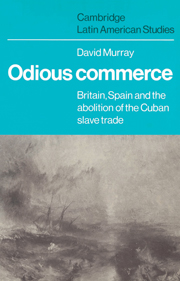Book contents
- Frontmatter
- Contents
- Tables
- Preface
- 1 The ‘opening’ of a legal trade
- 2 Parliament versus Cortes
- 3 Legality and illegality
- 4 The treaty of 1817
- 5 Enforcement and re-enforcement: the attempt to make the slave trade prohibition effective
- 6 The treaty of 1835
- 7 An abolitionist era
- 8 The Turnbull affair
- 9 The Escalera conspiracy
- 10 The penal law of 1845
- 11 Free trade and annexationism
- 12 The failure of the penal law
- 13 A new class of slaves
- 14 The abolition of the Cuban slave trade
- Abbreviations
- Notes
- Bibliography
- Index
- CAMBRIDGE LATIN AMERICAN STUDIES
9 - The Escalera conspiracy
Published online by Cambridge University Press: 16 October 2009
- Frontmatter
- Contents
- Tables
- Preface
- 1 The ‘opening’ of a legal trade
- 2 Parliament versus Cortes
- 3 Legality and illegality
- 4 The treaty of 1817
- 5 Enforcement and re-enforcement: the attempt to make the slave trade prohibition effective
- 6 The treaty of 1835
- 7 An abolitionist era
- 8 The Turnbull affair
- 9 The Escalera conspiracy
- 10 The penal law of 1845
- 11 Free trade and annexationism
- 12 The failure of the penal law
- 13 A new class of slaves
- 14 The abolition of the Cuban slave trade
- Abbreviations
- Notes
- Bibliography
- Index
- CAMBRIDGE LATIN AMERICAN STUDIES
Summary
Swirls of historical controversy still surround both Turnbull's role in a mass slave conspiracy in 1844 and the very existence of the conspiracy itself. Duvon C. Corbitt, writing in the 1930s, said: ‘There are few incidents in the history of Cuba about which there is more uncertainty than there is about the slave uprising of 1843, and the slave conspiracy supposed to have been discovered the following year.’ Historians continue to take diametrically opposed positions in their interpretation of what happened. Franklin Knight has claimed that ‘the supposed slave “revolt” of 1844 had absolutely no foundation in fact’, while Arthur F. Corwin not only accepts the fact of a slave conspiracy but, following an earlier generation of Cuban historians, sees Turnbull as the cause of the revolt and the one who conceived the idea. Another American historian, Gwendolyn Midlo Hall, has concluded, ‘there is little doubt that the conspiracy among the estate slaves was very real and extraordinarily well organized’.
Peninsular historians, anxious to demonstrate the reality of a British abolitionist offensive against Spain's major colony, wrote some of the earliest accounts of the events of the 1844 uprisings. Two semi-official Spanish histories which appeared in the 1870s magnified British abolitionist influence within Britain itself and overseas. British abolitionists dominated successive British governments and their sole purpose was to destroy slavery, regardless of the means used. After succeeding in abolishing slavery within the British empire, they sought to extend their social revolution to other slave states.
- Type
- Chapter
- Information
- Odious CommerceBritain, Spain and the Abolition of the Cuban Slave Trade, pp. 159 - 180Publisher: Cambridge University PressPrint publication year: 1981



